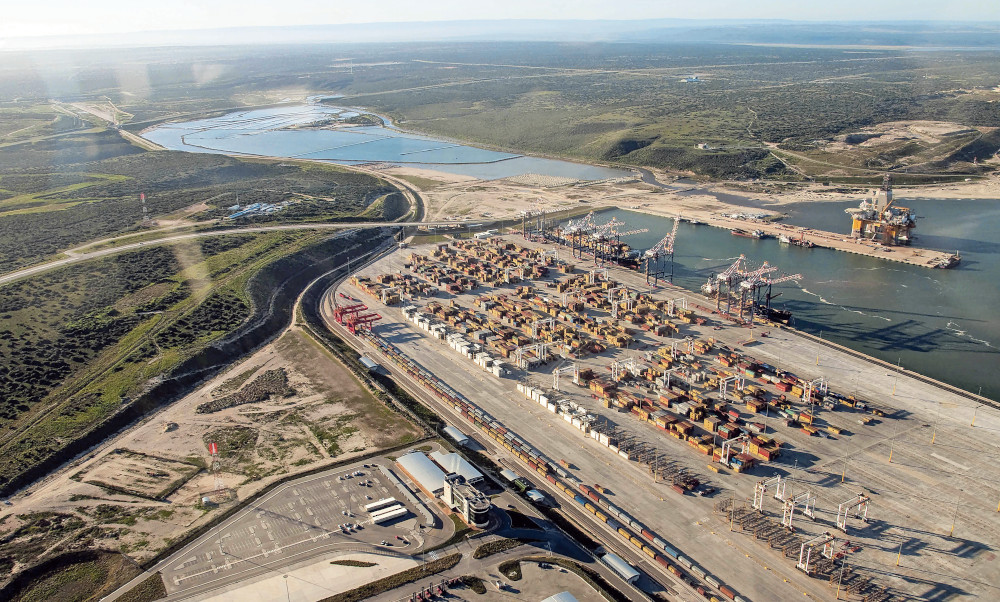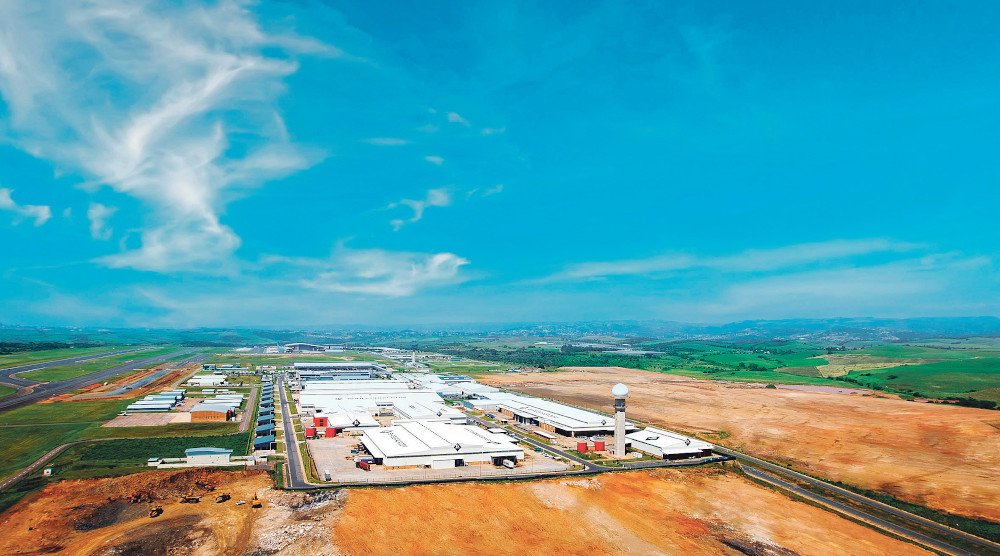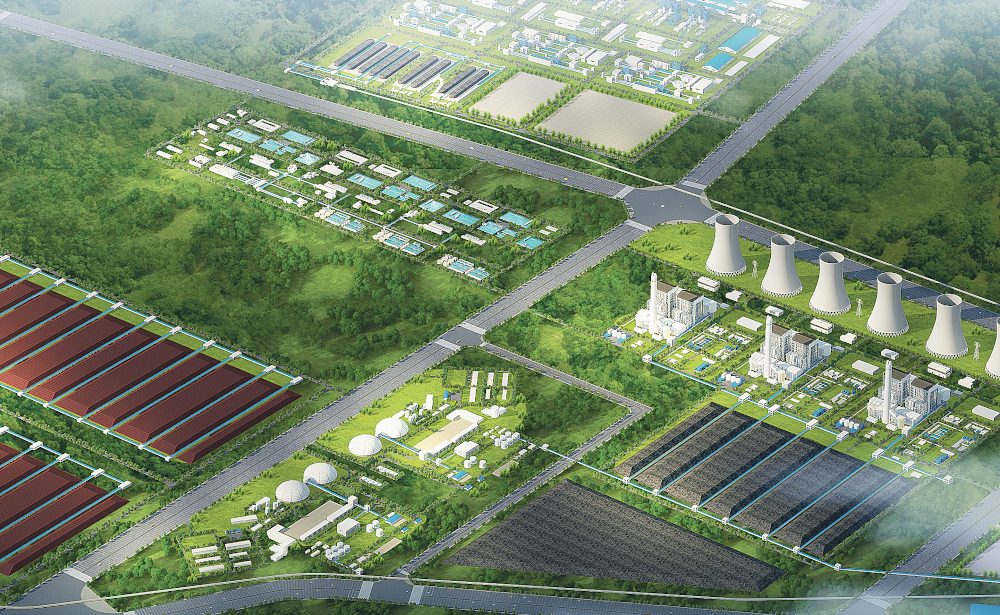Special Economic Zones create jobs. In South Africa’s current economic predicament, this is pure gold. The Tshwane SEZ is expanding for the manufacturing of the next generation Ford Ranger bakkie, and SMMEs will also benefit in the process. (Photo: Stefan Kleinowitz/Bloomberg via Getty Images)
President Cyril Ramaphosa’s announcement of a massive R16-billion investment in the Tshwane Special Economic Zone brings hope at a time when the economies of the country and the world are battling to recover from the effects of the coronavirus and lockdowns.
As the global economy seeks ways to recover from a slump that cost an estimated 220-million jobs, this investment will provide South Africans with much-needed employment.
Ramaphosa said the Ford Motor Company had announced the multi-billion rand investment to expand its manufacturing facility in Tshwane for the next-generation Ford Ranger bakkie. “This investment will support the growth of around 12 small and medium enterprises in automotive component manufacturing,” he said.
Ramaphosa added that nearly half of the procurement spend on construction of the bulk earthworks and top structure at the Tshwane Special Economic Zone (TSEZ) during this phase is expected to be allocated for SMMEs. He said this would amount to an estimated R1.7-billion in procurement opportunities.
A week after Ramaphosa’s announcement Statistics South Africa, in its Quarterly Labour Force Survey for the fourth quarter of 2020, laid bare the stark reality of the country’s unemployment situation.
The survey showed that the number of unemployed persons increased by 701 000 to 7.2-million compared to the third quarter of 2020. It also noted that the number of discouraged work-seekers increased by 235 000 (8.7%), resulting in a net decrease of 890 000 in the economically active population.
However SEZs can contribute to economic growth and the battle against unemployment. The Special Economic Zones Act 16 of 2014 provides for the designation, promotion, development, operation and management of SEZs. Several SEZs, among them the Tshwane SEZ, have been designated since the act was signed into law in February 2016.
In a 2019 paper titled Special Economic Zones: Lessons from the Global Experience, global economist Douglas Zhihua Zeng argued that SEZs can be an effective instrument to promote industrialisation if implemented properly in the right context, as shown in some of the emerging countries, particularly those in east Asia.
“More and more countries have begun to implement this instrument for their industrialisation process, especially as a way of attracting foreign direct investments (FDIs), mostly in the manufacturing sector, creating jobs, generating exports and foreign exchanges, and so on,” he wrote.
The World Bank says in a report titled China’s Experience and Lessons Learned, that China has successfully leveraged SEZs for economic transformation. “Initially SEZs were used to experiment with market-oriented economic reforms and build experience, before reforms were implemented more widely,” the report said.
Presently South Africa has 11 SEZs located in different parts of the country. The Tshwane Automotive SEZ is the latest SEZ, launched in 2019. There are plans to add five extra SEZ programmes by the Department of Trade, Industry, and Competition (DTIC). These include the proposed Bojanala SEZ in the North West province; Namakwa SEZ in the Northern Cape, the Vaal SEZ in Gauteng, the Tubatse SEZ in Limpopo and the Wild Coast SEZ in the Eastern Cape.
The SEZ fund is designed to provide funding for SEZ infrastructure and related operator performance improvement initiatives aimed at accelerating manufacturing and internationally traded service operations growth within identified zones.
The SEZ programme is seen as a critical project, central to the country’s “efforts to reignite economic growth by attracting investment with the greatest potential for sustainable growth and development”.
According to the DTIC, the SEZ programme continues to make inroads in the contribution of the country’s economy. It is reported that the SEZ programme has to date attracted 234 investors, whose investments have a combined estimated value of R61-billion. Almost half of these investors are active in the SEZs and are creating an estimated 15 000 direct jobs.
Ramaphosa said in his discussions about the 2020 State of the Nation Address in parliament that the government is exploring opportunities to boost local manufacturing and job creation through renewable energy programmes within the SEZs.
“We are exploiting these through our special economic zones, using them to strengthen our industrialisation drive and bring development to local areas,” he said.
Ramaphosa said the Coega SEZ now has a mature portfolio, with one large anchor investor. “Dube TradePort is located at a key logistics hub, well positioned to decrease the time taken to deliver a product to global markets,” Ramaphosa said.
“Using learnings from our own Coega SEZ, the Coega Development Corporation is providing advisory services to governments and the private sector in the development of SEZs across the African continent,” he concluded.
Coega leads the way
 The Coega SEZ in the Eastern Cape has advanced socioeconomic growth through skills development, technology transfer and job creation. (Photo: Rainer Schimpf)
The Coega SEZ in the Eastern Cape has advanced socioeconomic growth through skills development, technology transfer and job creation. (Photo: Rainer Schimpf)
The Coega SEZ in the Eastern Cape, which is the largest in the sub-continent, is located in the Nelson Mandela Bay Metro, and was designated in 2001 to become the country’s first Industrial Development Zone (IDZ). It is located on the east-west trade route, to service both world and African markets.
The Coega IDZ leverages public-sector investment to attract foreign and domestic direct investment in the manufacturing sector, with an export orientation. The IDZ has attracted investment in the agro-processing, automotive, aquaculture, energy, metals logistics and business process services sectors. This has advanced socioeconomic development in the Eastern Cape through skills development, technology transfer and job creation.
In October 2020, the Coega Development Corporation (CDC) announced grand plans to create 900 employment opportunities through the Coega Aquaculture Development Zone (ADZ).
This was billed as a “catalyst project funded by the Department of Economic Development, Environmental Affairs & Tourism (DEDEAT) to the tune of R206-million through the Provincial Stimulus Fund”, according to the CDC.
Earlier this month the Richard’s Bay Special Economic Zone announced that the Mara Group had pledged a R1-billion investment in a smartphone factory at the Dube TradePort.
The RBSEZ said this was the latest in a string of inward investments which include expenditure of more than R1.2-billion by Arçelik, the Turkish owner of Defy, at the company’s three South African plants.Two of the plants, the RBSEZ said, are in KwaZulu-Natal.
“The Special Economic Zones at Richards Bay and King Shaka International Airport (Dube TradePort) are key components of the strategy of attracting investors to the province. Dube TradePort attracted R7-billion between 2012 and 2019 and the same amount is expected to accompany the development of Phase 1A and Phase 1F of the Richards Bay Industrial Development Zone (RBIDZ).”
The RBIDZ said a further two investors in 2019 were edible oils manufacturer Wilmar Processing SA, which is investing more than R1-billion in a plant, and Elegant Afro Line, which will spend about R900-million on its chemicals plant.
“There are plans to establish a clothing and textiles SEZ in the province to build on the province’s established strength in the sector and an automotive supplier park will be in operation by 2021. Toyota and Bell Equipment play a big role in the automotive sector, while the Engen Oil Refinery is a strategic asset.”
In December the Musina Makhado SEZ in Limpopo announced that as a result of the development of the Medupi Power station in Lephalale, the MMSEZ will be used as a catalytic initiative to unlock various developmental opportunities in Musina and Makhado.
It said that given the magnitude of the MMSEZ, which is similar in size to the Medupi Power Plant, various socioeconomic infrastructure initiatives will be unlocked such as water, electricity, ICT, roads, rail, an airport, human settlement, health facilities, tourism facilities, and education and training. These will be of immense value to the province.
“Already the entity has completed an External Master Plan, outlining the required socio-economic infrastructure to support the MMSEZ. In the light of these multiple opportunities, the entity has commissioned a study for a ‘New Smart City Model’ to guide the envisaged spatial development path over a medium/long-term horizon.
“The development of the New Smart City will be guided by a co-ordinated investment in broadband infrastructure and the deployment of ICT capabilities as an enabler.”
Special Economic Zones a win-win for investors and job seekers
Investors into South Africa’s Special Economic Zones benefit from tax benefit schemes aimed at encouraging participation in the economic plans.
 Dube TradePort, a Special Economic Zone in KwaZulu-Natal that offers numerous opportunities for public-private partnerships.
Dube TradePort, a Special Economic Zone in KwaZulu-Natal that offers numerous opportunities for public-private partnerships.
“The tax incentives that companies may qualify for include VAT and customs relief if located within a Customs-Controlled Area (CCA), employment tax incentive, building allowance and reduced corporate income tax rate,” the Department of Trade, Industry and Competition (DTIC) said.
Another plus for investors is that all employers of low-salaried employees (below R60 000 per annum) in any SEZ will be entitled to the employment tax incentive (ETI).
“This aims to encourage employers to hire young and less experienced work seekers. However, the employee age restriction will not apply to SEZs. It reduces an employer’s cost of hiring people through a cost-sharing mechanism with the government, while leaving the wage the employee receives unaffected.”
The DTIC said the employer can claim the ETI and reduce the amount of Pay-As-You-Earn (PAYE) tax payable by the amount of the total ETI calculated in respect of all qualifying employees.
According to the DTIC, the design and eligibility criteria for each incentive seeks to strike a balance between achieving the objectives of higher levels of investment, growth and employment creation, and ensuring that the incentives are appropriately targeted for efficiency purposes, while minimising any deadweight loss to the fiscus.
“Business located within a CCA will qualify for VAT and customs relief similar to that for the current IDZs [Industrial Development Zones]. The employment tax incentive will be available to businesses located in any SEZ.”
Businesses operating within SEZs approved by the minister of finance, after consultation with the DTIC minister, are eligible for two additional tax incentives. “Firstly, all such businesses can claim accelerated depreciation allowances on capital structures (buildings) and, secondly, certain companies (carrying on qualifying activities within an approved SEZ) will benefit from a reduced corporate tax rate (i.e. 15% instead of 28%).”
The SEZ programme is a central part of South Africa’s efforts to reignite economic growth by attracting strategic investments with the greatest potential for sustainable growth and development.
“Since the introduction of the SEZ Act in 2016, there has been massive interest from investors to locate in the SEZs. This is attested by rand value of signed and not operational investors,” said the DTIC.
Plans are already underway to process additional pending SEZ applications that are at various stages of development. This is part of efforts to further optimise the country’s comparative and competitive endowments.
The most notable of these include the proposed Bojanala SEZ in the North West, Namakwa SEZ in the Northern Cape, Vaal SEZ in Gauteng, Tubatse SEZ in Limpopo and the Wild Coast SEZ in the Eastern Cape.
The SEZ Act and the draft strategy are meant to encourage the private sector to play a more active role in the SEZ programme. It is understood that public-private partnerships in the development and operation of SEZs offer the potential of different models.
These include assembly of land parcels with secure title and development rights by the government for lease to private zone development groups; and a building, operation and transfer model to onsite zone infrastructure and facilities with government guarantees and/or financial support. It also includes the contracting of private management in government-owned zones or the lease of government-owned assets by private operators.
MMSEZ final EIA application report submitted to the competent authority
The Musina Makhado Special Economic Zone (MMSEZ) SOC submitted the final Environmental Impact Assessment (EIA) Application Report on 1 February 2021 to the legally designated competent authority, the Limpopo Department of Economic Development, Environment and Tourism.

MMSEZ Chief Executive Lehlohonolo Masoga says: “The journey of the MMSEZ EIA application started in 2018 with a detailed Environmental Screening Study, followed by a scoping report in 2019. The scoping report identified a myriad of specialist studies to be conducted and we are pleased that in our endeavour to comply with the law, protect the environment and positively respond to the concerns raised by the public, we commissioned even more studies beyond the scope demanded by the competent authority.
“We are also pleased that throughout the EIA application process consultations with relevant communities, affected and interested parties have been the hallmark of the exercise. Our consultation with communities and other stakeholders was not just an act of compliance with the law, but a reflection of our values and principles as a public entity embedded in people-driven and people-centered governance,” says Masoga.
“It is for this reason that a record of over 3 000 comments were received. We are delighted that this process has created an opportunity to identify potential blind spots and missing links for the success of the project and the realisation of sustainable development.”
Section 24 of the South African constitution states that: “Everyone has the right to an environment that is not harmful to their health or wellbeing and to have the environment protected, for the benefit of present and future generations, through reasonable legislative and other measures that prevent pollution and ecological degradation; promote conservation; and secure ecologically sustainable development and the use of natural resources while promoting justifiable economic and social development.”
Furthermore, the National Environmental Management Act principles state that: “Environmental management must place people and their needs at the forefront of its concern, and serve their physical, psychological, developmental, cultural and social interests equitably, and that development must be socially, environmentally and economically sustainable.”
Masoga says: “As a public entity we are committed to sustainable development, which is an integral part of our values and policy framework. Although fairly new, we are proud to be one among [many] public entities that have adopted internal policies of the Environment, Social and Governance Policy.”
The SOC is not only sensitive to the reality of the water situation confronting the country and in particular Limpopo Province, but also to the fact that there are water shortages for supporting mega-industrial initiatives such as the envisaged SEZ. Accordingly the MMSEZ, as a catalytic initiative, has created a massive opportunity for the Limpopo government to provide a sustainable long-term solution to the water problem.
It is for this reason that investigations are underway for the development of a new Musina Dam on the confluence of the Limpopo and Sand rivers. Preliminary outcomes indicate that the initiative is technically sound and commercially viable. To this effect, the MMSEZ has consummated a partnership with Infrastructure South Africa, which is located in the Presidency of the Republic and the Development Bank of Southern Africa in order to bring the ambitious water project to fruition.
Masoga says: “Ultimately, the goal of this pioneering project is the provision of a sustainable water supply not only for the MMSEZ, but for the multitudes of the residents of Limpopo.”